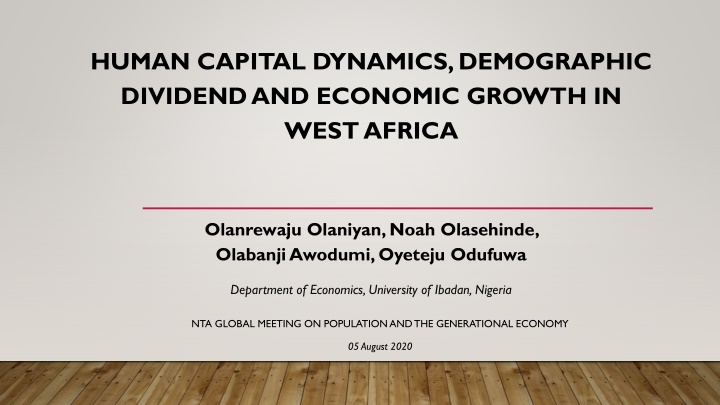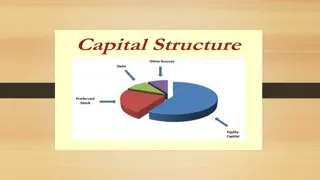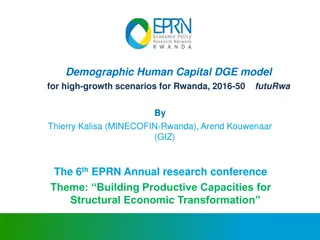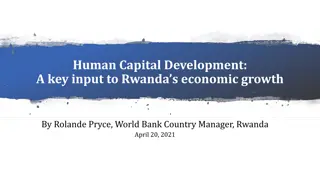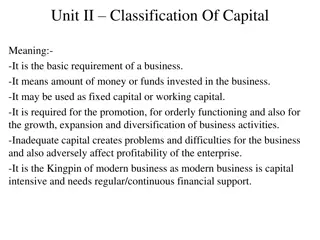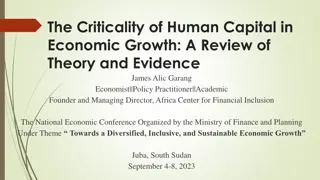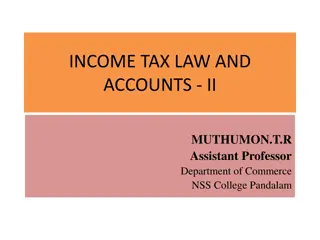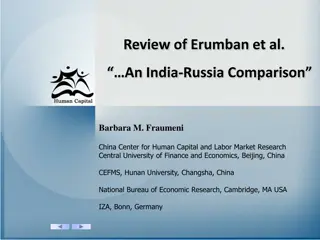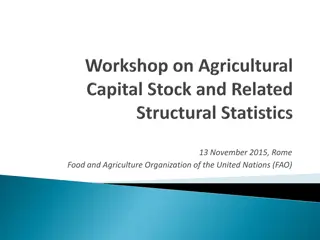Human Capital Dynamics in West Africa: Implications for Economic Growth
Concerns surrounding demographic dynamics and economic growth in West Africa are explored, focusing on population size, age structure, and implications for human capital development and GDP per capita. The role of demographic dividend and various theoretical perspectives are discussed within the context of population projections and school enrollment trends.
Download Presentation

Please find below an Image/Link to download the presentation.
The content on the website is provided AS IS for your information and personal use only. It may not be sold, licensed, or shared on other websites without obtaining consent from the author.If you encounter any issues during the download, it is possible that the publisher has removed the file from their server.
You are allowed to download the files provided on this website for personal or commercial use, subject to the condition that they are used lawfully. All files are the property of their respective owners.
The content on the website is provided AS IS for your information and personal use only. It may not be sold, licensed, or shared on other websites without obtaining consent from the author.
E N D
Presentation Transcript
HUMAN CAPITAL DYNAMICS, DEMOGRAPHIC DIVIDEND AND ECONOMIC GROWTH IN WEST AFRICA Olanrewaju Olaniyan, Noah Olasehinde, Olabanji Awodumi, Oyeteju Odufuwa Department of Economics, University of Ibadan, Nigeria NTA GLOBAL MEETING ON POPULATION AND THE GENERATIONAL ECONOMY 05 August 2020
Introduction Recent growing concerns on the implication of demographic dynamics for economic growth among governments, international organisation and other stakeholders the lack of consensus on the role of population and its growth on economic growth The recent interest in demographic dividend Three strands of the theoretical literature The earliest view - population size and its growth hinder economic growth (Hirchman 1958) The optimists - population size enhances economic growth (Sarel 1995) The neutralists - economic growth is not influenced by population size and population growth (Solow 1956 and Kelley 1988) Recent perspectives (age-structure) as economic need and behaviour of people tend to vary at various stages of life (Bloom et al. 2013).
Population Dynamics in West Africa Population Size of West Africa ( 000) Total Population of West Africa with Low, Medium and High Projections ( 000) With the high fertility projection, the population of West Africa will reach the 1.48 billion people mark by year 2100. This increase is driven by high fertility and mortality rates over the period. declining Source: United Nations Population Division, World Population Prospect 2019 Country Grouping based on available economic zone Nigeria (7th largest country globally) Other West Africa Monetary Zone (WAMZ): Ghana, The Gambia, Liberia and Sierra Leone West African Economic and Monetary Union (UEMOA): Benin, Burkina Faso, Cote D Ivoire, Guinea Bissau, Mali, Niger, Senegal and Togo. Cabo Verde and Guinea are added to this group for ease of analysis.
Age structure of the population of West Africa is changing slowly than other regions of the world Population figures in the region have followed a remarkable increasing trend Dictated by the path fertility and mortality rates Dominated by young persons who consist of over 60% of the population Implication for school enrolment, hence human capital development Rising primary school enrolment in the UEMOA and WAMZ group Declining primary school enrolment in Nigeria Menace of out-of-school children Irrespective of this trend, gross domestic product (GDP) per capita in West Africa rose by about 42% between 1980 and 2018.
GDP Growth rate (Annual %) GDP per Capita Source: Author, based on data from the World Bank World Development Indicators dominant youthful population improved economic performance inadequate human capital development
School enrolment, primary (% gross) 120 100 80 60 40 20 0 2012 2014 2016 1982 1984 1986 2000 2007 2008 2010 2011 2013 2015 2018 1980 1981 1983 1985 1988 1999 2004 2006 2009 2017 1987 1989 1992 1994 1995 1996 2001 2002 2003 2005 1990 1991 1993 1998 1997 UEMOA WAMZ(excluding Nigeria) Nigeria West Africa WAMZ
Children out of school (% of primary school age: 2010-2018) 35 30 25 20 15 10 5 0 WAMZ(excluding Nigeria) UEMOA West Africa Nigeria WAMZ
Health indicator for Survival and Fraction of Children under 5 not Stunted (2017) Probability of Survival to Age 5 Total Female 0.90 0.91 0.92 0.92 0.91 0.92 0.94 0.94 0.95 0.96 0.91 0.92 0.93 0.93 0.89 0.90 0.92 0.92 0.90 0.91 0.95 0.96 0.89 0.90 0.93 0.93 0.92 0.92 Survival Rate from Age 15 to 60 Total Female 0.76 0.79 0.75 0.77 0.61 0.64 0.74 0.77 0.76 0.78 0.75 0.76 0.77 0.79 0.74 0.75 0.76 0.77 0.65 0.67 0.82 0.85 0.61 0.62 0.74 0.75 0.73 0.75 Fraction of Children Under 5 Not Stunted Total Female 0.66 0.68 0.73 0.78 0.75 0.77 0.81 0.83 0.68 0.68 0.70 0.70 0.72 0.58 0.56 0.59 0.83 0.85 0.74 0.72 0.72 0.73 0.71 0.73 Male 0.90 0.91 0.90 0.93 0.95 0.91 0.92 0.89 0.91 0.89 0.95 0.88 0.92 0.91 Male 0.74 0.74 0.59 0.72 0.74 0.74 0.75 0.73 0.74 0.63 0.78 0.60 0.72 0.71 Male 0.64 Benin Burkina Faso Cote d'Ivoire Gambia, The Ghana Guinea Liberia Mali Niger Nigeria Senegal Sierra Leone Togo ECOWAS 0.74 0.80 0.65 0.67 0.54 0.81 0.76 0.72 0.70
MODEL SPECIFICATION Traditional growth models as variously augmented with demographic factors by Bloom and Finlay (2009), Aiyar and Mody (2013), and Ahmad and Khan, (2018). Y = f(L, K, D) .1 In line with Ahmad and Khan, (2018); GDPG = f(L_GDPG, WP, TLFPR, LG, PG, KG, GLE, TRD, EDU, FLFPR, AGR, HC) ..2 where Demographic variables: Economic variables: GDPG = GDP per capita growth rate, L-GDPG = lagged value of GDP per capita WP = working age population ratio, TLFPR = labor force participation ratio, LG = growth rate of total labor force, PG = growth rate of population (PG). KG = growth rate of capital stock, GLE = growth rate of life expectancy, TRD = trade openness, EDU = education expenditures, FLFPR = female labor force participation rate, AGR = agriculture productivity.
Accounting for demographic dividend (DD) (rather than working population), and differences across economic zones: GDPG = f(L_GDPG, DD, TLFPR, LG, PG, KG, GLE, TRD, EDU, HLT, FLFPR, AGR, HC, WAMZ, UEMOA, Nigeria) 3 The panel form of equation 3 is specified for the baseline model and model with other economic variables respectively: GDPGit = 0 + 1L_GDPGit + 2DDit + 3TLFPRit + 4LGit + 5PGit + 6KG + 7WAMZ, 8UEMOA) 4 GDPGit = 0 + 1L_GDPGit + 2DDit + 3TLFPRit + 4LG + 5PGit + 6KGit + 7GLE + 8TRDit + 9EDUit + 10FLFPRit + 11AGRit + 12WAMZ + 13UEMOA) 5 In equations 4 and 5, UEMOA, WAMZ and Nigeria are dummy variables with Nigeria representing the reference category.
Analysis is conducted in two stages Stage 1: The National Transfer Accounts (NTA) methodology which quantifies economic flows for single- year age cohorts was used to obtain demographic dividend. The NTA identity for each age cohort (x) is written as: C(x) YI(x) = +(x) -(x) + YA(x) S(x) 6 The lifecycle deficit, net transfer inflows and asset-based reallocations are represented by (C(x) YI(x)), ( +(x) -(x)) and (YA(x) S(x)) respectively. Following Mason and Lee (2006), demographic dividend (growth of support ratio) is obtained as: ?? ? = ?(?) ?(?) 7 Positive growth of the support ratio indicates that the number of effective producers grows faster than the number of effective consumers. Stage 2 Random (equations 4a and 5a) and fixed (equations 4b and 5b) effects panel regression methods are adopted to estimate the models Robustness to data with small sample size (panels with N smaller than T) Consistent and efficient estimates Valid model is selected based on Hausman specification test
Data Population data were extracted from 2019 world population prospects of United Nations. National Transfer Accounts (NTA) Data were extracted from NTA database Data for other variables were obtained from the World Bank World Development Indicators. Scope: 1980 - 2018
Effect of Demographic Dividend and human capital on economic growth Variable Baseline Model Model with control variables Random Effect Fixed Effect Random Effect Fixed Effect L_GDPG -0.034(0.056) -0.083(0.057) -0.088(0.055) -0.113(0.056)** DD 2.278(0.642)* 1.223(0.897) 1.29(0.720)*** -0.030(0.981) LG -2.167(0.510)* -2.217(0.596)* -2.606(0.508)* -2.291(0.588)* Empirical Results KG -0.002(0.004) -0.004(0.004) -0.003(0.004) -0.005(0.004) TLFPR -0.010(0.030) -0.101(0.112) -0.200(0.092)** -0.151(0.226) PG 3.222(0.647)* 4.380(0.791)* 4.263(0.680)* 4.714(0.796)* FLFPR - - 0.161(0.066)* 0.160(0.149) TRD - - 0.060(0.017)* 0.069(0.020)* GLE - - 0.072(0.93) 0.073(0.094) AGR - - -0.003(0.024) -0.021(0.045) EDU - - 0.006(0.013) 0.009 (0.018) UEMOA -0.619(0.918) - -1.072(1.007) - WAMZ -0.784(0.939) - -2.544(1.051)* - Constant -0.322(1.936) 2.607(8.210) -2.188(2.750) -9.326(10.446) Wald Chi/F-stat 35.95* 3.34* 64.26* 3.47* Hausman 2.01 8.82
Existence of Demographic Dividend in West Africa Positive impact of demographic dividend on per capita income growth An increase in the benefit that accrues from the decline in mortality and fertility rate promotes accelerated economic growth Complementary role of female labour participation rate and trade openness Growth of total labour force may be detrimental for growth, especially given the widespread underutilization of human resources and the grossly inadequate capital stock to complement the functioning of labour Healthy and skilful workforce are important elements of economic growth
Conclusion Demographic dividend contributed significantly to per capita income growth in West Africa The increasing working population needs to be complemented with adequate human capital development Positive influence of human capital on economic growth Vibrant and flexible labour markets is important for harnessing demographic dividends for long term growth in West Africa The West African Monetary Zone (Ghana, Sierra Leone and The Gambia) have significantly lower GDP growth than in Nigeria The West African Economic and Monetary Union (UEMOA), including Guinea, is not significantly different
Implications for Policy Governments should prepare themselves to put in place policies and actions to accelerate and realise potential dividend that the current population dynamics offers Investment in quality education and health The labour market needs to be as flexible as possible to absorb the large cohorts entering the working ages in the next 25 years Enhance the environment that will give opportunities to young people to have decent jobs. Provision of job-matching assistance, offer training and mentoring Prioritize job creation in national development strategies Need to deepen regional integration
